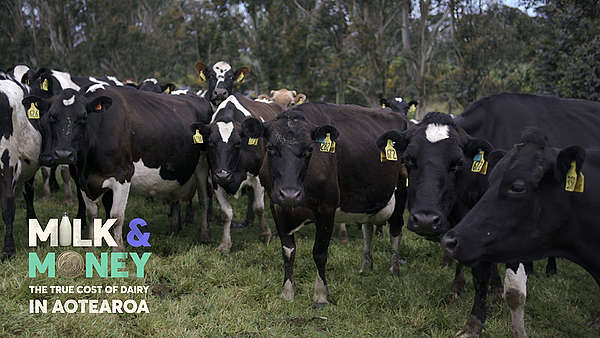We’re always on the lookout for good documentaries – and Milk & Money is exactly that. It’s an in-depth look at intensive dairying in New Zealand and how the dairy industry is affecting our economy, rivers, animals, communities and health.
Greenpeace Aotearoa has been standing up against the harm done by intensive dairying for years. We’re not the only ones that can see the devastating effects of too many cows, too much synthetic nitrogen fertiliser and too much imported feed. From sick, slimy rivers to climate catastrophe, there’s evidence all around us that intensive dairying has outgrown the land.
What can we do instead of intensive dairying?
Watch the Milk & Money series for some ideas, and check out our proposal for Government support for farmers to shift to regenerative farming that works with nature, not against it.
Episode one: Money
What exactly is the dairy industry selling? How does it work, and why exactly has intensive dairying boomed in the past few decades? And how does debt stop farmers from moo-ving towards more environmentally-friendly practices, like regenerative farming?

Episode two: Water
Water is essential for life. We all deserve to know that the water from our tap is clean and safe. But pollution from intensive dairying is turning rivers sick and slimy, choking out native fish and plants, and turning our drinking water toxic. Find out why – and steps we can take to fix the problem.

Episode three: Feed & fertiliser
If you’ve been following Greenpeace for any amount of time, you’ll know that we’re calling on the Government to phase out synthetic nitrogen fertiliser and imported feed, like palm kernel expeller. As this episode of Milk & Money describes, that’s because of the impacts these inputs cause while driving ever-more intensive dairying.

Episode four: Emissions
Agriculture contributes about half of New Zealand’s climate pollution. And the majority that comes from intensively-farmed dairy herds. Find out why this is and what it means for Aotearoa’s future in this episode of Milk & Money.

Episode five: Land and soil
“Dairy’s focussed on the short-term goal of growing as much grass as you can.” More grass = more cows that can be kept on the land. But what’s that doing to the soil? What are the impacts for the intricate network of fungi, microbes, minerals and bugs under the ground that sustains, well, everything?

Episode six: Milk
This episode takes a look at how cows are treated in intensive dairying operations, and how we can actually make milk without cows. Spoiler alert: contains shots of cute calves.


Join our call on the Government to go further than the Climate Commission’s inadequate recommendations and cut climate pollution from NZ’s biggest polluter: industrial dairying.
Take Action



